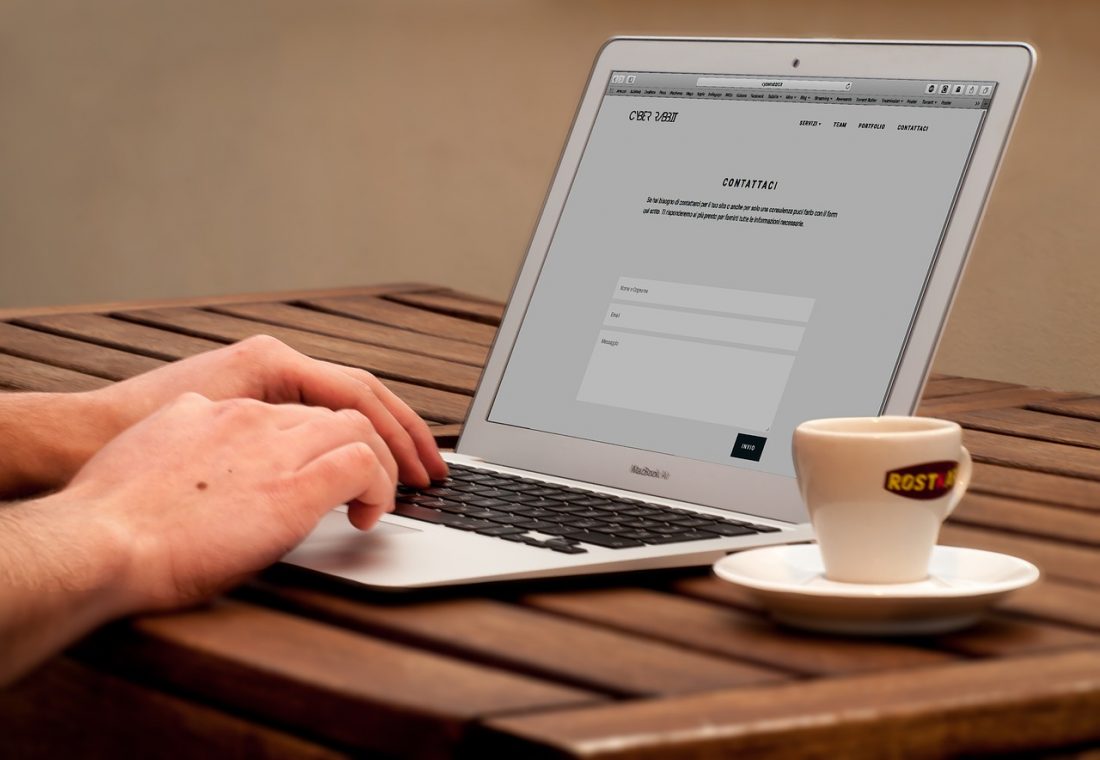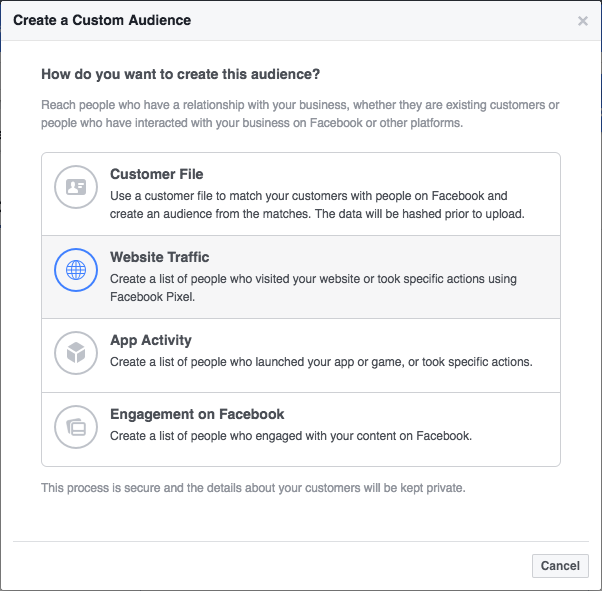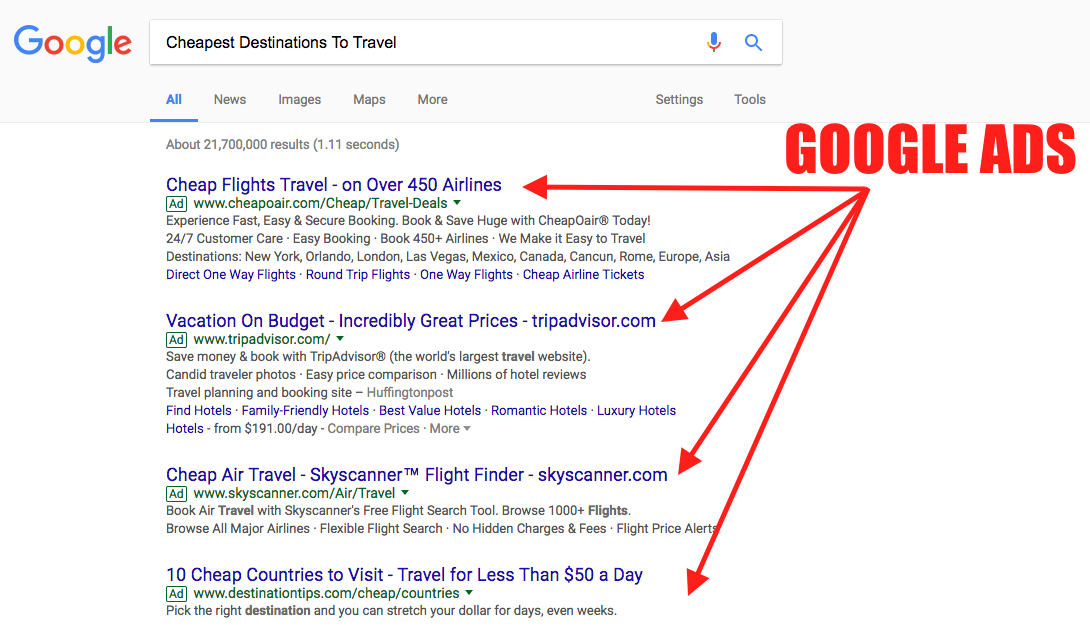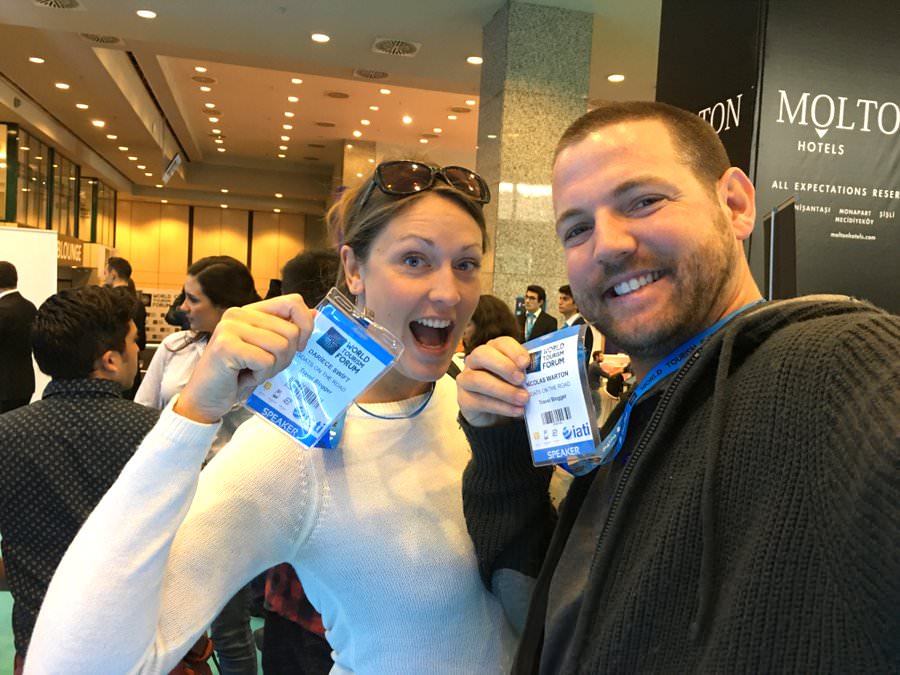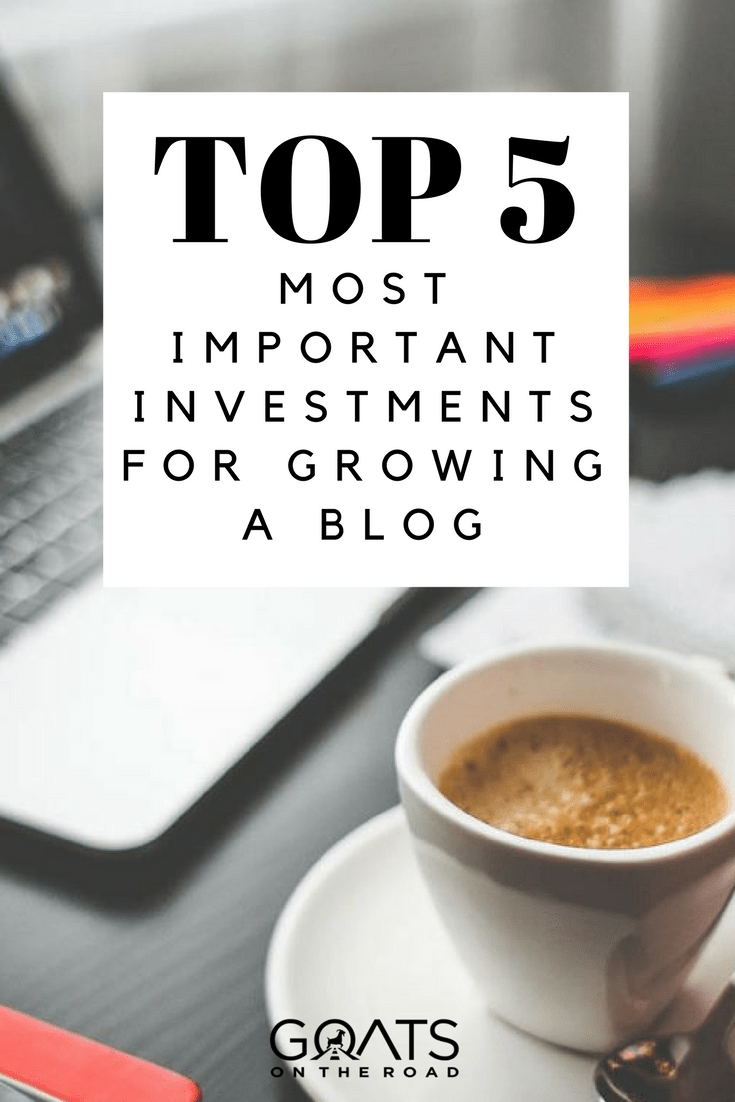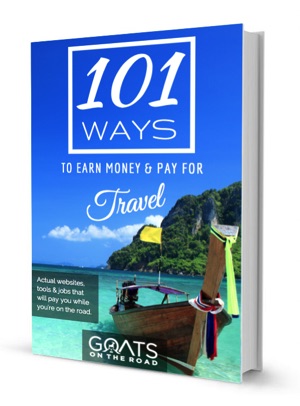If you’ve started your blog using our step-by-step guide and received our eBook, then you’ll already know how important investing money back into a growing online business can be. If you’re wanting to learn how to start a travel blog, or you’ve already started one yourself, then this post will still be extremely helpful for you.
When we first started this travel blog back in 2012, we were overwhelmed by everything we had to do in order to just get it off the ground. There are so many things to think about and before your blog starts making any money, you have to do all of the jobs yourself – marketing the blog, designing the blog, growing your social media, etc.
It can definitely be a full-time job.
But as your blog starts to grow and you see the opportunity to monetize it and earn some money, you need to start thinking about what investments you should make to help it grow larger, faster and more profitable. There are loads of things you can spend money on, and some new entrepreneurs waste thousands of dollars by investing in the wrong things at the wrong time.
There’s no point in paying money for advertising if you don’t have anything to convert visitors to sales on your website. There’s no point in paying someone to edit your videos for you if you rarely post on YouTube and have no subscribers.
It’s important that you make smart investments at the right times in order to grow your business as quickly and efficiently as possible. In this article, I’m going to list, in order, the top 5 most important FIRST investments that every growing blog should make.
1. Design
In my opinion (and the opinion of many other bloggers and online experts), website design is the second most important factor (next to excellent content of course) in keeping new visitors on your site and influencing them to return time and time again.
However, new bloggers, and those already making a few thousand dollars per month from their sites are always hesitant to invest one, two, three or five thousand dollars on a website design (don’t worry, I’m going to cover some cheaper options in this section as well). A custom design is a huge investment, but believe me, it’s one that pays its dividends over time.
Internet readers have an extremely short attention span. Even the most interesting websites usually only keep readers on their pages for 3 – 4 minutes.
Before we had Scott Eldridge of Eldo Web Design create a fully bespoke Goats On The Road theme for us, we were averaging just one minute visit time on each page. Now we’re nearly double that, thanks to an aesthetically pleasing design and smart button and link placements that help our click-through rates.

When people stay on your website longer, they’re more likely to share your content, click your affiliate links, sign up for your newsletter and buy your products. If you decide to run Google Adsense on your blog, then longer visits also mean more ad revenue.
You need to catch people’s eye in the first few minutes of being on your site. Your pages have to load extremely fast and you need to give them plenty (but not too many) opportunities to click to other related pages on your site and convert by sharing, signing up for your newsletter, purchasing etc.
Whatever investment you make towards your website design, you need to make sure that it’s 100% mobile responsive. Google has already announced that it will stop ranking sites that aren’t mobile friendly, so you need to make sure that your site looks just as good on a 52 inch screen as it does on a 5.2 inch screen. It needs to be mobile optimized and have a full mobile version, or Google will stop displaying it in search results.
Here are a few routes you can take when investing into your blog design, starting from the most expensive and moving towards the cheaper end of the spectrum:
Fully Bespoke Theme
UPDATE 2018: There is a new WordPress plugin available that’s truly a game-changer for web design and it’s called Thrive Architect. If this was available when we started, it would have saved us thousands of dollars on designers and web-developers. The plugin is called Thrive Architect and while it currently doesn’t allow you to create a custom theme, when paired with a good free WordPress theme it will allow you to drag and drop professional looking designs for important pages on your site. We’ve used this plugin to design other sites and I can’t believe it’s only $67 when I paid $4000 for a design before! They’re also coming out with a drag-and-drop theme builder which will allow you to customize your entire site!
A fully bespoke design is one that is created by a professional developer that doesn’t use a standard WordPress theme as the framework. Most blog designs you see online today are just basic themes, a few of those have been redesigned by developers and even fewer have been created from scratch (like Goats On The Road is).
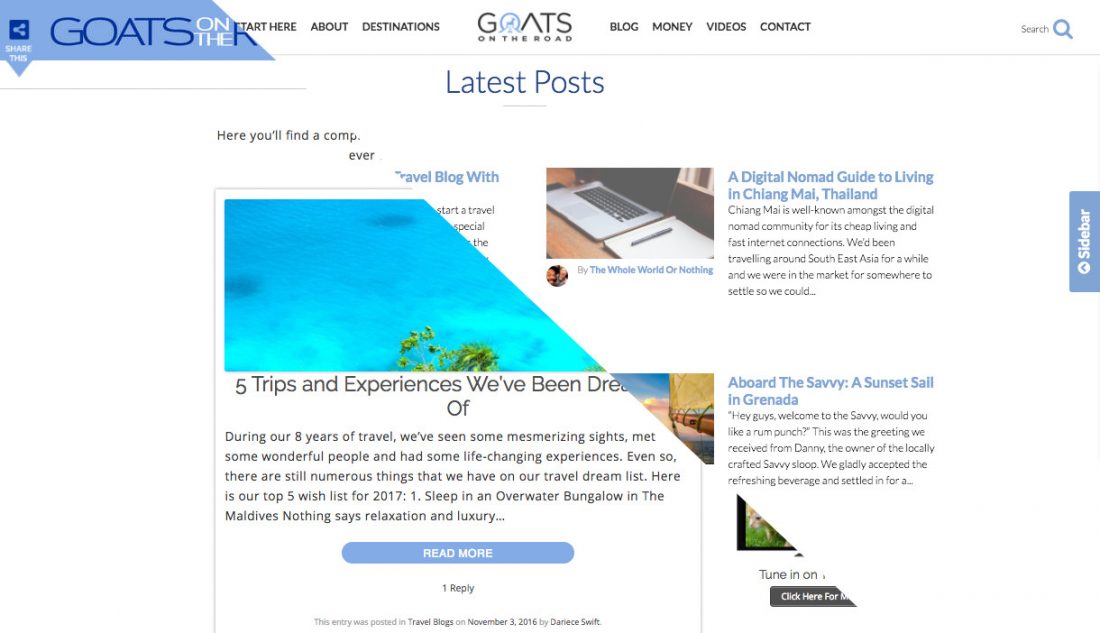
A bespoke theme will load faster, work better, be completely unique and thus, more memorable to new visitors. It will ditch all the add ons and extras that come with bulky themes and give you exactly what your site needs to run quickly and smoothly.
A bespoke theme will probably cost you anywhere from $2,500 – $10,000, so it’s not an investment that a growing blog is likely to make (but it’s one you should consider down the road). But there are some cheaper options as well.
Premium WordPress Theme
A cheaper route to take is to purchase a Premium WordPress Theme. Many people immediately go to Divy, or other drag-and-drop themes so that they can design their blog easily to look exactly how they want it. BE CAREFUL with these types of themes. They are extremely heavy, meaning they’re slow to load, and they create some messy coding.
Consider purchasing a nice theme that looks good right away. One that you’ll only have to make minor styling changes to and one that’s compatible with a lot of plug-ins. This post covers quite a few excellent premium WordPress themes to help you choose.
Premium Plugins
If you’re not willing or ready to invest $2,500 in a bespoke design, or $50 – $100 in a custom theme, then you can add to your free WordPress theme by installing plugins.
There are quite a few excellent free plugins for travel bloggers, but there are also a few that you can purchase that can help your site. These are definitely the cheapest way to design and optimize your site if you’re already using a free WordPress theme.
Interactive Maps Plugin: This is the plugin that we use to display clickable maps on our site like you see on our Videos Page and our Destinations Page. These maps are a great way to show readers all the places that you’ve created content about. We purchased this from Code Canyon for $21.
Social Fans Counter: That funky little plugin that displays all of our social media accounts at the bottom of every page, along with their follower numbers and a running total. This one was also purchased on Code Canyon for $17.
InstaShow Instagram Plugin: At the bottom of our site you’ll see a line of photos taken directly from our Instagram feed and when you hover over them, you can like and comment. This plugin is great if you’re trying to grow your Instagram and it costs $19 on Code Canyon.
ConstantContact / Convert Kit: As soon as you start growing your blog, you should start growing an email list. You should have a place for people to enter their name and email on every page of your website. Even if you’re only sending them a newsletter ones every three months, you should be collecting these emails because these will be your best customers down the road.
For beginners, ConstantContact is a great option and it comes with a Thrive Architect, my favourite blog design plugin. It’s free for the first month and then goes up in price incrementally after that. ConvertKit is a bit more expensive (depending on how many subscribers you have), but it’s great for advanced users and helps conversions.
2. Upgrades
Growing a blog and online business quickly and efficiently is all about productivity. You need to be as effective as possible, every time you sit down at your laptop. You also need your website to load as fast as possible so that you don’t lose new readers, which is why it’s important to upgrade your servers and hosting plan when needed.
It’s important to purchase the best equipment, internet package and server hardware that you can afford. For the former, it’s vital that you ensure that your electronics aren’t getting in the way of your travels and lifestyle.
Electronic Upgrades
Of course, the best computer you can have is some kind of massive tower with a 42 inch screen, 128 GB of RAM and a 3 TB SSD hard drive, but you’re not going to be travelling and living around the world with a desktop computer are you? Similarly, the best camera may be a massive DSLR and the best drone might be the Inspire 2, but these may not be practical for a digital nomad lifestyle.
For us, the optimal vlogging camera is the Canon G7x Mark II, the optimal drone is the DJI Spark and the best photography camera for size is likely a mirrorless like the Fujifilm X-T2.
A perfect balance between quality and convenience is what you should strive for when choosing the best hardware. If you’re doing a lot of video or photo editing on your computer, then you should have a Macbook Pro with 16 GB of RAM and a 1 TB SSD hard drive. If your Mac is an older version, you can upgrade this for less than $250.
If you’re spending a lot of time in Adobe Premier Pro, Final Cut, After Effects, Photoshop or Lightroom, then you know just how annoying those loading icons can be. For every second your workflow is halted to render, load, transcode or analyze, you’re wasting time that could be spent growing your business and making money.
It may only take your older computer a few minutes to render a clip or analyze a photo each time, but those minutes quickly add up. Trust me, if you upgrade your computer to double the RAM and hard drive speed, you’ll save hundreds of hours per year on editing. Those hours can be put towards writing an eBook, creating new affiliate posts or growing your social media.
I’ve already written Essential Time Saving Electronic Upgrades that all Digital Nomads Should Consider so if you haven’t read it yet, check it out.
Internet Upgrade
If you’re a digital nomad who’s constantly travelling, then this won’t really pertain to you, but if you’re renting an apartment long-term, then you should definitely consider asking the owner to upgrade the internet for you.

Most AirBnBs and apartment rentals around the world have the cheapest, slowest internet possible. Talk to the owner and tell them you’ll pay for any upgrade costs. Usually it will only run you about $10 – $50 extra dollars per month for the faster internet, but it could save you a lot of time in the long run.
Server & Hosting Upgrades
While you’re considering upgrading your tangible hardware (like cameras, computers and microphones), you should also consider upgrading your website’s hardware through your host. Speed is not only important for efficiency of your work, but it’s also vital for the health of your website, both for your readers and for search engines.
Click Here to test the speed of your website. If your home page and other popular pages take more than 4 seconds to load, then you should consider upgrading your servers.
Google has already stated that it’s taking website load speed into consideration when ranking websites in search results, so you need to make sure that your site loads as fast as possible. You can check with your host and see what upgrades you can make to the websites RAM, caching networks, CPU and hosting servers.
You can also upgrade your hosting package to a private, cloud, or dedicated server for a bit extra per month.
Ask your host to have a look at your site and recommend the upgrades that will have the largest impact on your site loading speed for the least amount of money.
Liking This Article? Pin it!
3. Hire VAs (Virtual Assistants)
This one is huge. As soon as your site starts making money and you feel overwhelmed by the tasks of social media, writing posts, editing posts, design, marketing and emails, you should hire a Virtual Assistant to help you.
Most bloggers put this off for a long time because they tell themselves “I only spend 15 minutes per day quickly doing this task, I can just do it myself”. This is the wrong way to think. If it’s a task that can be done by someone else, then you should delegate it to a VA.
To maximize your growth, you need to spend time doing tasks that only you can do, like writing blog posts, shooting videos, and communicating with advertisers, press partners and tourism boards.
For all of your mundane tasks on social media and on your blog, you should have one VA. Not only will it free up your time to spend on more important items, but your VA will quickly become better at the tasks than you ever were. This will be their only job with you. They will hone their skills and within a month or two, they will be able to complete the tasks faster and better than you ever could.
💡 Bonus Tip: Have your VA complete our 6 Day Social Media Success Schedule and our 6 Day Blog Success Schedule each week.
The same goes for any other repetitive tasks that you find yourself doing on your site. The minute you have money, you should consider hiring a VA.
You can usually find VAs on websites like UpWork, Guru and Fiverr, but another great way is to post in a travel blogging Facebook group that you’re looking for a VA. More often than not, there will be a VA in the group, or a blogger who has a VA who is looking for more work. This is a great way to find new assistants because you can hire them on the recommendations of other bloggers in the industry.
4. Advertising
Your awesome content can only get you so far. Eventually you will have to start investing in advertising to ensure that your photos, shares, videos and articles reach a broader audience. In many businesses, advertising will be your first investment. Before most companies are even profitable, they’ll have a monthly ad spend. But I believe that online businesses (like blogs) are different.
It is my belief that you should at least be making enough money from your website to be sustainable, before you start spending a lot of money on ads. Sure when you’re starting out, you can run a Facebook ad to get likes on your page or try to create a profit positive AdWords campaign, but in general, you don’t need to spend a lot of money on advertising until you are making a decent income (think: $1,500 / month or more).
This is because there are so many things a blogger can do to market themselves without spending a dime. You can pitch yourself to big media sites like BBC Travel, Business Insider, NatGeo Traveller and Lonely Planet. You can write dozens of guest posts for big travel blogs in your niche. You can comment on different sites and build back links to help your organic SEO.
There is a lot to think about when growing a blog and you can start by exhausting all of your free options, before moving into paid advertising.
But when you start making a solid, reliable income from your blog, then you can start to invest in advertising. There are countless ways to advertise your site, but I’m going to list some of the most popular and effective ones here in this section:
Facebook Ads
The Facebook Ads Manager section is extremely confusing, overwhelming and frustrating. Don’t get discouraged! If you’re stuck, click the support tab and go on a live chat (or email) to get some help. Don’t waste your time messing around.
When you’re first starting out, there are only really 2 types of ads that are worth trying. Page Likes and Website Traffic to important pages. To get you started, I’ll help you with the basics.
IMPORTANT: Each of the types of Facebook ads follows the same step-by-step process. Choose the type of ad you want, where they’re displayed, the Audience they’ll reach and finally, the budget you’re willing to spend. The audience targeting is the most important section.
Make sure you choose countries that are likely to react, engage and continue liking and sharing your content down the road. Sure you can get 10,000 likes from Pakistan for very cheap (likes from Pakistan are inexpensive on Facebook), but unless your blog is Pakistan focused or you already have a large Pakistani following, this audience could be useless to you as an English travel blogger who has never visited Pakistan.
Focus on countries with residents who are likely to travel to the places you write about, who speak English and who are already inline with your current audience (which you can find under demographics in Google Analytics).
You should make your target audience even more specific by choosing their interests. If your blog is all about budget travel, then be sure to add that into the “interests” section of the audience targeting page. To add interests, simply type them in the box and then click the relevant options that appear.
Likes On Your Page: When you create a new ad in Ads Manager, you’ll have a bunch of options. One of these options is “Engagement”. If you click that icon, you can then choose the “Page Likes” option. If you can afford $30 / month, then set the budget to $1 / day and run it for a month. Make sure you choose an audience that will not only “like” your Facebook page, but continuously engage with your posts down the road. Choose English-speaking countries and add in interests that coincide with your target audience.
Traffic To Your Website: This is great if you have a page that converts well for affiliate or product sales. There’s really no point in sending a ton of visitors to your home page, unless your confident that you have a high conversion rate (ie: newsletter subscribers or webinar sign-ups) on your home page.
A great way to utilize Facebook Ads is to create an ad that sends people to a high converting site on your page, or remarketing visitors who have already spent some time on that page, but didn’t convert.
To create an Ad that simply sends people to your high-converting page, all you have to do is click the “Traffic” option in Ads manager and go about the normal steps of choosing a well-defined audience and an affordable budget.
Make sure you choose interests that pertain to the post you’re sending them to. For example, if you’re sending people to a page where they can purchase your eBook about the Top 50 Cheap Countries in the World, then you should make sure you’re targeting people who have an interest in budget travel and frugal living.
If you’re trying to remarket readers who have visited your important pages, but didn’t convert, you can easily do this with Facebook Ads. If someone visited your Top 50 Cheap Countries in the World eBook page, but didn’t end up buying it, you can remind them with a nice little ad in their Facebook feed.
To do this, you have to first add a Facebook Tracking Pixel to all of the pages on your website. After you do that, you can choose a custom audience in the audience section of Ad Manager. Then you can choose “People Who Have Visited Your Website” or even “People Who Have Visited Specific Pages On Your Website”.
If you choose specific pages, you simply enter the URLs of the pages that you want to target and voila. If someone visited those pages in the past 1 – 90 days (you decide the cookie duration in Facebook Ads Manager), then they’ll see your ad appear in their feed or on the side bar on Facebook.
I’m sure you’ve noticed that after you visit certain websites or certain product pages on Amazon, you see ads for those products all over your Facebook feed? Well now you know the secret.
Instagram Ads
Since Instagram was acquired by Facebook on April 9th of 2012, all Instagram ads are run through the Facebook Ads Manager. So I don’t need to go into much detail, because they follow the same formula as what I’ve described above. All you have to do is choose “Instagram” in the placements section of Facebook Ads manager.
Keep in mind that Instagram videos can only be 1 minute long, so if your ad is a video and you want it to appear on Instagram as well, you’ll have to make sure it’s 60 seconds or less.
Google AdWords
Before Facebook Ads came along, Google AdWords was pretty much the only place where businesses and bloggers went to create ads. It is a highly focused way to get visitors to your site because you can choose what keywords your site will appear under in search results.
Let’s say you want your Cheapest Countries eBook sales page to appear in search results when people Google “Cheapest Countries”, “Cheapest Destinations” and “Cheapest Places To Travel”.
You can do this with Google AdWords. First you’ll have to create an account, then you’ll have to create a new ad set, choose your keywords and place your bid. Google gives you an “Estimated CPC” which helps you decide if you want to bid on the keyword. CPC means cost per click and it’s pretty self-explanatory, if the CPC is $1 and your ad gets 100 clicks from Google, it’ll cost you $100.
Google AdWords campaigns can be frustrating, because most terms that are obviously easy to convert (like How To Start a Blog) have an extremely expensive CPC, so you need to know that you’re going to convert a lot of visitors before investing $5+ per click into AdWords.
I really can’t word it any better than Neil Patel did on his KissMetrics Blog post:
Max CPC = (profit per customer) x (1 – profit margin) x (website conversion rate)
For example, let’s say your average profit per customer is $500, and out of 1,000 website visitors you convert 10 into customers. That means you have a 1% website conversion rate. If you are comfortable with a 30% profit margin, then here’s how you would calculate your Max CPC:
Max CPC = $500 x (1 – 0.30) x 1% = $3.50
Again, your Max CPC must be in the neighborhood of the estimated CPC in Google’s Keyword Tool or else you’re in trouble. If your Max CPC is $3.50 and the estimated CPC for a keyword is $10, then you’ll need to first increase either your profit per customer or your conversion rate before you can profitably advertise on that particular keyword.
Basically, you don’t want to invest a bunch of money into Google Adsense if you’re not converting enough readers to be profit positive. Google Adsense is difficult to master, but if you can launch a profit-positive campaign, you can make a lot of money.
5. Conferences
Finally, I recommend investing some money to go to at least one conference. When you’re first starting out, you won’t likely have TBEX contacting you to fly you to their Europe Summit to be a speaker, so you’ll have to spend some of your own money to purchase a ticket, get yourself there and put yourself up in a hotel room.
Conferences are great for learning from those in the blogging business and networking. I can’t stress enough just how important it is that you network with other bloggers in your niche and brands in your industry when you’re starting out.
There are tons of different conferences you can attend outside of TBEX. There’s Inflow,World Tourism Forum, VidCon (for YouTubers), ITB in Berlin, World Travel Market and many more. Before you choose which one you want to go to, consider your goals for the conference. Is it to meet other bloggers and learn how they’ve become successful in the industry? Or, are you looking to meet brands and tourism boards to hire you?
If it’s the former, make sure you check the attendee list before purchasing your ticket. Make sure that there are a bunch of knowledgeable bloggers in your niche who are attending before you decide to go.
We’ve been lucky enough to meet and learn from Tim Leffel of The Cheapest Destinations Blog, Jarryd & Alesha from Nomadasaurus, Dave & Deb from The Planet D, Justin Carmack from The Art of Scuba Diving, Johnny Ward of One Step 4 Ward, Jonathan and Kach of Two Monkeys Travel Group and so many more. Because we met them all in person, we have formed a much more solid relationship. And over time, we’ve found different ways to work with together, or at least bounce ideas off of one other.
If you’re hoping to meet up with tourism boards and brand marketers at the conferences, then check to see that there will be brands there that fit your niche. If you’re a budget traveller and only 5 star resorts and luxury tour companies are attending the event, then choose another one!
Most people go to these conferences to meet up with potential business partners, but I believe that it’s far more valuable to network with your fellow bloggers and learn from them. Invest a bit of money to go to a couple of conferences when you’re starting out and if you choose wisely, it could give your blog a much-needed boost.
Summary
For a business to grow, you need to invest in it. You need to invest a lot of risk, a considerable amount of time and finally, a lot of money.
Start with investing in the design of your blog. Think of it as your store front. You want people walking by (surfing by) to be impressed and have a good first impression.
Invest in the efficiency of your business. Not just in the speed of your computer, but the speed of your wi-fi and the load time of your website as well.
Once you’re making enough to sustain your lifestyle, it’s time to invest in VAs to help you with repetitive tasks and in Ads to help you reach new audiences. And finally, once you’ve grown an audience and a brand that is worth partnering with, you can consider investing in travel influencer conferences, summits and meet-ups around the world.
Investing money back into your business is just as important as investing time into it. If you’re too cheap with your own business to nurture it with some cashflow, then it will never grow beyond a certain point. Somebody once said: “You need to spend money to make money” and that has never been truer than it is with blogging and online entrepreneurship.
Spend your money wisely and watch your business grow before your eyes. Give it boosts where it needs them and never stop helping it grow organically. Investing smartly is the true key to success in this competitive online space, and now you have to tools and knowledge to make some intelligent first investments and start seeing real returns from them.
Good luck!
Like This Article? Pin it!






